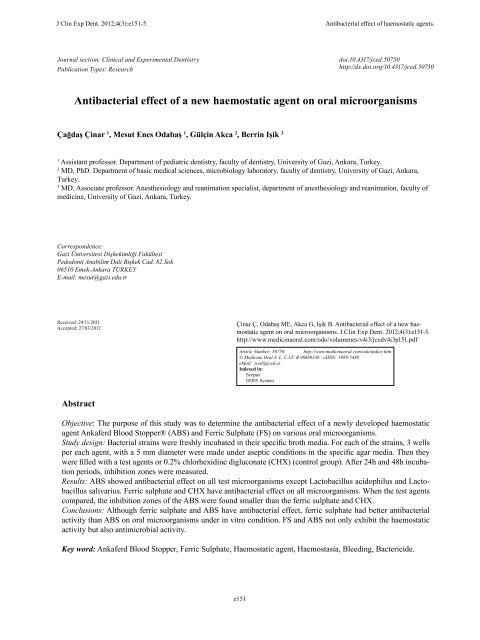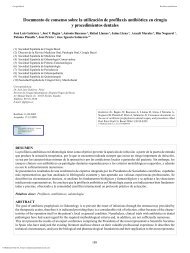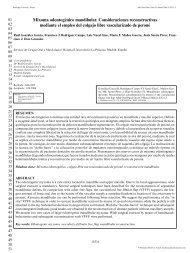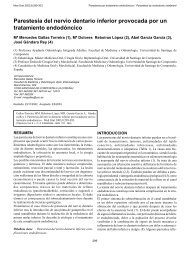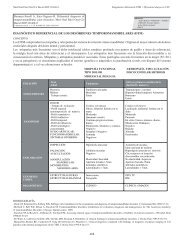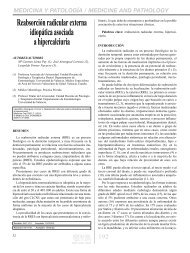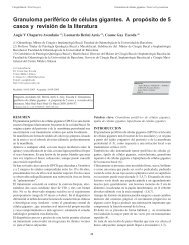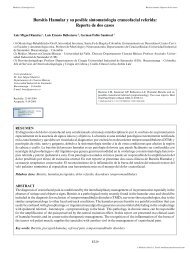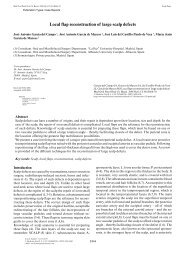Antibacterial effect of a new haemostatic agent on - Medicina Oral ...
Antibacterial effect of a new haemostatic agent on - Medicina Oral ...
Antibacterial effect of a new haemostatic agent on - Medicina Oral ...
Create successful ePaper yourself
Turn your PDF publications into a flip-book with our unique Google optimized e-Paper software.
J Clin Exp Dent. 2012;4(3):e151-5. <str<strong>on</strong>g>Antibacterial</str<strong>on</strong>g> <str<strong>on</strong>g>effect</str<strong>on</strong>g> <str<strong>on</strong>g>of</str<strong>on</strong>g> <str<strong>on</strong>g>haemostatic</str<strong>on</strong>g> <str<strong>on</strong>g>agent</str<strong>on</strong>g>s.<br />
Journal secti<strong>on</strong>: Clinical and Experimental Dentistry<br />
Publicati<strong>on</strong> Types: Research<br />
<str<strong>on</strong>g>Antibacterial</str<strong>on</strong>g> <str<strong>on</strong>g>effect</str<strong>on</strong>g> <str<strong>on</strong>g>of</str<strong>on</strong>g> a <str<strong>on</strong>g>new</str<strong>on</strong>g> <str<strong>on</strong>g>haemostatic</str<strong>on</strong>g> <str<strong>on</strong>g>agent</str<strong>on</strong>g> <strong>on</strong> oral microorganisms<br />
Çağdaş Çinar 1 , Mesut Enes Odabaş 1 , Gülçin Akca 2 , Berrin Işik 3<br />
1 Assistant pr<str<strong>on</strong>g>of</str<strong>on</strong>g>essor. Department <str<strong>on</strong>g>of</str<strong>on</strong>g> pediatric dentistry, faculty <str<strong>on</strong>g>of</str<strong>on</strong>g> dentistry, University <str<strong>on</strong>g>of</str<strong>on</strong>g> Gazi, Ankara, Turkey.<br />
2 MD, PhD. Department <str<strong>on</strong>g>of</str<strong>on</strong>g> basic medical sciences, microbiology laboratory, faculty <str<strong>on</strong>g>of</str<strong>on</strong>g> dentistry, University <str<strong>on</strong>g>of</str<strong>on</strong>g> Gazi, Ankara,<br />
Turkey.<br />
3 MD, Associate pr<str<strong>on</strong>g>of</str<strong>on</strong>g>essor. Anesthesiology and reanimati<strong>on</strong> specialist, department <str<strong>on</strong>g>of</str<strong>on</strong>g> anesthesiology and reanimati<strong>on</strong>, faculty <str<strong>on</strong>g>of</str<strong>on</strong>g><br />
medicine, University <str<strong>on</strong>g>of</str<strong>on</strong>g> Gazi, Ankara, Turkey.<br />
Corresp<strong>on</strong>dence:<br />
Gazi Üniversitesi Dişhekimliği Fakültesi<br />
Pedod<strong>on</strong>ti Anabilim Dali Bişkek Cad. 82.Sok<br />
06510 Emek-Ankara TURKEY<br />
E-mail: mesut@gazi.edu.tr<br />
Received: 24/11/2011<br />
Accepted: 27/03/2012<br />
Abstract<br />
Çinar Ç, Odabaş ME, Akca G, Işik B. <str<strong>on</strong>g>Antibacterial</str<strong>on</strong>g> <str<strong>on</strong>g>effect</str<strong>on</strong>g> <str<strong>on</strong>g>of</str<strong>on</strong>g> a <str<strong>on</strong>g>new</str<strong>on</strong>g> <str<strong>on</strong>g>haemostatic</str<strong>on</strong>g><br />
<str<strong>on</strong>g>agent</str<strong>on</strong>g> <strong>on</strong> oral microorganisms. J Clin Exp Dent. 2012;4(3):e151-5.<br />
http://www.medicinaoral.com/odo/volumenes/v4i3/jcedv4i3p151.pdf<br />
Article Number: 50750 http://www.medicinaoral.com/odo/indice.htm<br />
© <strong>Medicina</strong> <strong>Oral</strong> S. L. C.I.F. B 96689336 - eISSN: 1989-5488<br />
eMail: jced@jced.es<br />
Indexed in:<br />
Scopus<br />
DOI® System<br />
Objective: The purpose <str<strong>on</strong>g>of</str<strong>on</strong>g> this study was to determine the antibacterial <str<strong>on</strong>g>effect</str<strong>on</strong>g> <str<strong>on</strong>g>of</str<strong>on</strong>g> a <str<strong>on</strong>g>new</str<strong>on</strong>g>ly developed <str<strong>on</strong>g>haemostatic</str<strong>on</strong>g><br />
<str<strong>on</strong>g>agent</str<strong>on</strong>g> Ankaferd Blood Stopper® (ABS) and Ferric Sulphate (FS) <strong>on</strong> various oral microorganisms.<br />
Study design: Bacterial strains were freshly incubated in their specific broth media. For each <str<strong>on</strong>g>of</str<strong>on</strong>g> the strains, 3 wells<br />
per each <str<strong>on</strong>g>agent</str<strong>on</strong>g>, with a 5 mm diameter were made under aseptic c<strong>on</strong>diti<strong>on</strong>s in the specific agar media. Then they<br />
were filled with a test <str<strong>on</strong>g>agent</str<strong>on</strong>g>s or 0.2% chlorhexidine digluc<strong>on</strong>ate (CHX) (c<strong>on</strong>trol group). After 24h and 48h incubati<strong>on</strong><br />
periods, inhibiti<strong>on</strong> z<strong>on</strong>es were measured.<br />
Results: ABS showed antibacterial <str<strong>on</strong>g>effect</str<strong>on</strong>g> <strong>on</strong> all test microorganisms except Lactobacillus acidophilus and Lactobacillus<br />
salivarius. Ferric sulphate and CHX have antibacterial <str<strong>on</strong>g>effect</str<strong>on</strong>g> <strong>on</strong> all microorganisms. When the test <str<strong>on</strong>g>agent</str<strong>on</strong>g>s<br />
compared, the inhibiti<strong>on</strong> z<strong>on</strong>es <str<strong>on</strong>g>of</str<strong>on</strong>g> the ABS were found smaller than the ferric sulphate and CHX.<br />
C<strong>on</strong>clusi<strong>on</strong>s: Although ferric sulphate and ABS have antibacterial <str<strong>on</strong>g>effect</str<strong>on</strong>g>, ferric sulphate had better antibacterial<br />
activity than ABS <strong>on</strong> oral microorganisms under in vitro c<strong>on</strong>diti<strong>on</strong>. FS and ABS not <strong>on</strong>ly exhibit the <str<strong>on</strong>g>haemostatic</str<strong>on</strong>g><br />
activity but also antimicrobial activity.<br />
Key word: Ankaferd Blood Stopper, Ferric Sulphate, Haemostatic <str<strong>on</strong>g>agent</str<strong>on</strong>g>, Haemostasia, Bleeding, Bactericide.<br />
e151<br />
doi:10.4317/jced.50750<br />
http://dx.doi.org/10.4317/jced.50750
J Clin Exp Dent. 2012;4(3):e151-5. <str<strong>on</strong>g>Antibacterial</str<strong>on</strong>g> <str<strong>on</strong>g>effect</str<strong>on</strong>g> <str<strong>on</strong>g>of</str<strong>on</strong>g> <str<strong>on</strong>g>haemostatic</str<strong>on</strong>g> <str<strong>on</strong>g>agent</str<strong>on</strong>g>s.<br />
Introducti<strong>on</strong><br />
Haemorrhage c<strong>on</strong>trol is an essential factor in dental procedure<br />
for good visualizati<strong>on</strong> <str<strong>on</strong>g>of</str<strong>on</strong>g> the fields. Dentists perform<br />
variety operative procedures such as pulpotomy,<br />
tooth extracti<strong>on</strong>, biopsies, placement <str<strong>on</strong>g>of</str<strong>on</strong>g> endosseous implants,<br />
periradicular and period<strong>on</strong>tal surgery, which may<br />
require haemorrage c<strong>on</strong>trol (1, 2). The most widespread<br />
technique is to c<strong>on</strong>trol bleeding by applying mechanical<br />
pressure to wound surface. The use <str<strong>on</strong>g>of</str<strong>on</strong>g> cott<strong>on</strong> balls or<br />
gauze pads risk leaving fibers in the surgical site. These<br />
fibers may elicit a foreign body reacti<strong>on</strong> and delay<br />
healing (3). Another technique to c<strong>on</strong>trol bleeding is the<br />
applicati<strong>on</strong> <str<strong>on</strong>g>of</str<strong>on</strong>g> <str<strong>on</strong>g>haemostatic</str<strong>on</strong>g> <str<strong>on</strong>g>agent</str<strong>on</strong>g>s(4). Various <str<strong>on</strong>g>agent</str<strong>on</strong>g>s are<br />
used for hemorrhage c<strong>on</strong>trol in dentistry.<br />
Ferric sulphate (Fe 2 [SO 4 ] 3 ) has been used as a coagulative<br />
and <str<strong>on</strong>g>haemostatic</str<strong>on</strong>g> <str<strong>on</strong>g>agent</str<strong>on</strong>g> and it was first used in medicine<br />
in 1957. On c<strong>on</strong>tact with blood, the agglutinati<strong>on</strong><br />
<str<strong>on</strong>g>of</str<strong>on</strong>g> blood proteins result from the reacti<strong>on</strong> <str<strong>on</strong>g>of</str<strong>on</strong>g> blood with<br />
ferric and sulphate i<strong>on</strong>s. Thus the capillary orifices have<br />
been obturate by b<strong>on</strong>ded proteins (3).<br />
Medical plants have been marketed as antibacterial<br />
<str<strong>on</strong>g>agent</str<strong>on</strong>g>s and <str<strong>on</strong>g>haemostatic</str<strong>on</strong>g> <str<strong>on</strong>g>agent</str<strong>on</strong>g>s for many years (5, 6).<br />
Ankaferd Blood Stopper (ABS) (Ankaferd Sağlik Ürünleri<br />
A.Ş., Istanbul, Turkey) is a mixture <str<strong>on</strong>g>of</str<strong>on</strong>g> herbal medicine<br />
and it is recently developed to facilitate the rapid<br />
hemorrhage c<strong>on</strong>trol in difficult clinical c<strong>on</strong>diti<strong>on</strong>s (6).<br />
ABS ingredients a standard mixture <str<strong>on</strong>g>of</str<strong>on</strong>g> following plants:<br />
Thymus vulgaris (5.0g/100ml), Glycyrrhiza glabra<br />
(7.0g/100ml), Vitis vinifera (8.0g/100ml), Alpinia <str<strong>on</strong>g>of</str<strong>on</strong>g>ficinarum<br />
(7.0g/100ml) and Urtica dioica (6.0g/100ml).<br />
ABS stimulated rapid formati<strong>on</strong> <str<strong>on</strong>g>of</str<strong>on</strong>g> a protein network<br />
and erythrocyte aggregati<strong>on</strong>. The ABS-induced network<br />
formati<strong>on</strong> is related to the functi<strong>on</strong> <str<strong>on</strong>g>of</str<strong>on</strong>g> blood proteins and<br />
red blood cells. The basic mechanism <str<strong>on</strong>g>of</str<strong>on</strong>g> acti<strong>on</strong> for ABS<br />
appears to be the formati<strong>on</strong> <str<strong>on</strong>g>of</str<strong>on</strong>g> an encapsulated protein<br />
network that provides focal points for erythrocyte aggregati<strong>on</strong>.<br />
ABS also interacts with fibrinogen and other<br />
blood proteins. Exposure to ABS seems to provide tissue<br />
oxygenati<strong>on</strong> as well as a physiological <str<strong>on</strong>g>haemostatic</str<strong>on</strong>g><br />
process without affecting any individual clotting factor.<br />
This unique mechanism <str<strong>on</strong>g>of</str<strong>on</strong>g> acti<strong>on</strong> provides ABS with<br />
an advantage (7). ABS has been safely used in patients<br />
to treat epistaxis (8), after t<strong>on</strong>sillectomy (9) or variceal<br />
bleeding(10). In additi<strong>on</strong>, ABS has been used to c<strong>on</strong>trol<br />
upper gastrointestinal bleeding (11). Moreover the levels<br />
<str<strong>on</strong>g>of</str<strong>on</strong>g> coagulati<strong>on</strong> factors II, V, VIII, IX, X, XI, and XII<br />
were not affected by ABS; therefore, ABS might be used<br />
in patients with deficient primary haemostasis (12).<br />
Many microorganism species have been detected in the<br />
oral cavity; some <str<strong>on</strong>g>of</str<strong>on</strong>g> these bacterial species can cause<br />
several diseases and complicati<strong>on</strong>s. Infecti<strong>on</strong> <str<strong>on</strong>g>of</str<strong>on</strong>g> wounds<br />
is an important complicati<strong>on</strong> that impairs wound healing.<br />
A <str<strong>on</strong>g>haemostatic</str<strong>on</strong>g> <str<strong>on</strong>g>agent</str<strong>on</strong>g> should be bacteriostatic and/or<br />
bactericidal, when used in surgical wound. In this study,<br />
it was aimed to evaluate the potential antibacterial <str<strong>on</strong>g>effect</str<strong>on</strong>g><br />
e152<br />
<str<strong>on</strong>g>of</str<strong>on</strong>g> ABS and FS under in vitro c<strong>on</strong>diti<strong>on</strong>s.<br />
Materials and methods<br />
Ankaferd Blood Stopper®, ferric sulphate and 0.2%<br />
chlorhexidine digluc<strong>on</strong>ate (c<strong>on</strong>trol group) were screened<br />
for antimicrobial activity by using well-diffusi<strong>on</strong><br />
technique <strong>on</strong> agar plate.<br />
Bacterial Strain and Culture C<strong>on</strong>diti<strong>on</strong>s<br />
The antibacterial activity <str<strong>on</strong>g>of</str<strong>on</strong>g> each material was evaluated<br />
against Staphylococcus aureus (S. aureus) ATCC#25923,<br />
methicillin sensitive S.aureus (MSSA), methicillin resistant<br />
S. aureus (MRSA), Enterococcus faecalis (E.faecalis)<br />
(ATCC #29212), vancomycin resistant E. faecalis<br />
(VRE), Candida albicans (C.albicans)(ATCC#10231),<br />
Candida albicans oral isolate, Porphyrom<strong>on</strong>as gingivalis<br />
(P.gingivalis) (ATCC#33277), Lactobacillus acidophilus<br />
(L.acidophilus) (ATCC#4356), Lactobacillus<br />
salivarius (L.salivarius)(ATCC#11741), Streptococcus<br />
mutans (S.mutans) (ATCC#25175), Streptoccous sobrinus<br />
(S.sobrinus) (ATCC#33478) and Aggregatibacter<br />
actinomycetemcomitans (A.actinomycetemcomitans)<br />
(ATCC#29523).<br />
S.mutans and S.sobrinus, were cultured in 5 ml <str<strong>on</strong>g>of</str<strong>on</strong>g> brain<br />
heart infusi<strong>on</strong> broth (BHIB, Oxoid, UK) at 37 ºC for<br />
48 hours in an atmosphere <str<strong>on</strong>g>of</str<strong>on</strong>g> 5 % CO 2 . E.faecalis and<br />
S.aureus were cultured in 5 ml <str<strong>on</strong>g>of</str<strong>on</strong>g> brain heart infusi<strong>on</strong><br />
broth (BHIB, Oxoid, UK) at 37 ºC for 48 hours aerobically,<br />
L.acidophilus and L.salivarius were cultured at<br />
37 o C for 48 hours in 5 ml <str<strong>on</strong>g>of</str<strong>on</strong>g> MRS Broth (DeMan Rogosa<br />
and Sharpe Medium, Merck, Germany) in an atmosphere<br />
<str<strong>on</strong>g>of</str<strong>on</strong>g> 10% CO 2 . C.albicans was cultured in autoclaved-sterilized<br />
Sabourraud Dextrose Broth (SDB, Oxoid,<br />
UK) at 37 o C for 48 hours under aerobic c<strong>on</strong>diti<strong>on</strong>s. A.<br />
actinomycetemcomitans and P.gingivalis were cultured<br />
in autoclave-sterilized trypticase soy broth (Oxoid, UK)<br />
supplemented sheep blood (50 ml/L), Vit K (1µg/ml)<br />
and hemin (5µg/ml) at 37 o C for 4-5 days in an automatic<br />
anaerobic cabin (Electrotek AW400TG, UK) in the atmosphere<br />
c<strong>on</strong>sisted <str<strong>on</strong>g>of</str<strong>on</strong>g> 90% N 2 , 5% CO 2 , 5% H 2 . The last<br />
three ingredients were added to the main medium after<br />
filter-sterilized with 0.22µm millipore. All <str<strong>on</strong>g>of</str<strong>on</strong>g> the freshly<br />
grown bacterial suspensi<strong>on</strong>s in 5 ml <str<strong>on</strong>g>of</str<strong>on</strong>g> their specific broth<br />
media as described before were adjusted to 10 8 cfu/<br />
ml by using 0.5 Mc Farland test standard. For each <str<strong>on</strong>g>of</str<strong>on</strong>g><br />
the strains, 3 wells per each <str<strong>on</strong>g>agent</str<strong>on</strong>g> with a 5 mm diameter<br />
were made under aseptic c<strong>on</strong>diti<strong>on</strong>s in their specific agar<br />
media c<strong>on</strong>taining petri plates for each <str<strong>on</strong>g>of</str<strong>on</strong>g> the strains separately.<br />
Then the bacterial and fungal suspensi<strong>on</strong>s were<br />
spread <strong>on</strong> to their specific agar plates.<br />
The wells were filled with 20μl ABS (Ankaferd® Sağlik<br />
Ürünleri A.Ş.) and Ferric sulhate (15.5%) (Astringedent®,<br />
Ultradent Products Inc., Salt Lake City, UT,<br />
USA). 0.2% chlorhexidine digluc<strong>on</strong>ate (CHX) was selected<br />
as a positive c<strong>on</strong>trol group, because <str<strong>on</strong>g>of</str<strong>on</strong>g> its widespread<br />
clinical use; also it serves as a comm<strong>on</strong> point <str<strong>on</strong>g>of</str<strong>on</strong>g>
J Clin Exp Dent. 2012;4(3):e151-5. <str<strong>on</strong>g>Antibacterial</str<strong>on</strong>g> <str<strong>on</strong>g>effect</str<strong>on</strong>g> <str<strong>on</strong>g>of</str<strong>on</strong>g> <str<strong>on</strong>g>haemostatic</str<strong>on</strong>g> <str<strong>on</strong>g>agent</str<strong>on</strong>g>s.<br />
reference for comparis<strong>on</strong>s with other studies (13, 14).<br />
Then, they were incubated <strong>on</strong> their specific media under<br />
standard microbiological c<strong>on</strong>diti<strong>on</strong>s according to the<br />
growth properties as described before. After 48 hours the<br />
inhibiti<strong>on</strong> z<strong>on</strong>es around the wells were measured with<br />
a digital caliper (Mitutoyo, SP, Brazil) for P.gingivalis<br />
and A. actinomycetemcomitans and 24 hours for the rest<br />
<str<strong>on</strong>g>of</str<strong>on</strong>g> the others, The measurements were repeated after 48<br />
hours in the same manner. Tests were performed duplicate<br />
for all <str<strong>on</strong>g>of</str<strong>on</strong>g> these <str<strong>on</strong>g>agent</str<strong>on</strong>g>s and materials. All inhibiti<strong>on</strong><br />
z<strong>on</strong>es were measured at 24 and 48 hours by <strong>on</strong>e author.<br />
The results were statistically analyzed using One-way<br />
analysis <str<strong>on</strong>g>of</str<strong>on</strong>g> variance and Tukey’s tests for the significant<br />
interrelati<strong>on</strong> between the groups using SPSS 13.0 for<br />
Windows (SPSS Inc., Chicago, IL) with the level <str<strong>on</strong>g>of</str<strong>on</strong>g> statistical<br />
significance set at p0.05). CHX<br />
had the larger inhibiti<strong>on</strong> z<strong>on</strong>e than ABS (p
J Clin Exp Dent. 2012;4(3):e151-5. <str<strong>on</strong>g>Antibacterial</str<strong>on</strong>g> <str<strong>on</strong>g>effect</str<strong>on</strong>g> <str<strong>on</strong>g>of</str<strong>on</strong>g> <str<strong>on</strong>g>haemostatic</str<strong>on</strong>g> <str<strong>on</strong>g>agent</str<strong>on</strong>g>s.<br />
Discussi<strong>on</strong><br />
This article has described the antibacterial activity in<br />
vitro for <str<strong>on</strong>g>new</str<strong>on</strong>g>ly developed <str<strong>on</strong>g>haemostatic</str<strong>on</strong>g> <str<strong>on</strong>g>agent</str<strong>on</strong>g> ABS. In<br />
this study, stains <str<strong>on</strong>g>of</str<strong>on</strong>g> Streptococcus mutans, Streptococcus<br />
sobrinus, Lactobacillus acidophilus, Lactobacillus<br />
salivarius, Staphylococcus aureus, Methicillin-resistant<br />
staphylococcus aureus (MRSA), Methicillin-sensitive<br />
Staphylococcus aureus (MSSA), Enterococcus faecalis,<br />
Vancomycin-resistant Enterococcus faecalis (VRE),<br />
Candida albicans, C.albicans oral isolate, Porphyrom<strong>on</strong>as<br />
gingivalis, Aggregatibacter actinomycetemcomitans<br />
were used, which present in the oral cavity. S.mutans,<br />
S.sobrinus, Lactobacilli species that are known as cariogenic<br />
microorganisms play a major role in dental plaque<br />
formati<strong>on</strong>. S.aureus and E.faecalis are most comm<strong>on</strong>ly<br />
seen hospital infecti<strong>on</strong> <str<strong>on</strong>g>of</str<strong>on</strong>g> surgical wounds and infecti<strong>on</strong>s<br />
associated with indwelling medical equipment. S.aureus<br />
is also a human pathogen, and it causes systemic infecti<strong>on</strong>s<br />
such as wound infecti<strong>on</strong>s, pneum<strong>on</strong>ia, endocarditis,<br />
and septicemia. Porphyrom<strong>on</strong>as gingivalis and Aggregatibacter<br />
actinomycetemcomitans play a major role<br />
in period<strong>on</strong>titis and period<strong>on</strong>tal tissue destructi<strong>on</strong>.<br />
Agar well-diffusi<strong>on</strong> test is widely used in in-vitro method<br />
<str<strong>on</strong>g>of</str<strong>on</strong>g> evaluati<strong>on</strong> <str<strong>on</strong>g>of</str<strong>on</strong>g> antimicrobial activity <str<strong>on</strong>g>of</str<strong>on</strong>g> various<br />
chemicals. The size <str<strong>on</strong>g>of</str<strong>on</strong>g> inhibiti<strong>on</strong> z<strong>on</strong>e depends <strong>on</strong> the<br />
solubility <str<strong>on</strong>g>of</str<strong>on</strong>g> the test material, time and temperature <str<strong>on</strong>g>of</str<strong>on</strong>g><br />
incubati<strong>on</strong> (15). According to the other studies (6, 16),<br />
agar well diffusi<strong>on</strong> test was used in the present methodology<br />
to verify the inhibiti<strong>on</strong> z<strong>on</strong>e <str<strong>on</strong>g>of</str<strong>on</strong>g> the hemostatic<br />
<str<strong>on</strong>g>agent</str<strong>on</strong>g>s, because it was clearly seen and reported that this<br />
chemical did not dissolved in broth media such as Mueller<br />
Hint<strong>on</strong> Broth.<br />
Many <str<strong>on</strong>g>haemostatic</str<strong>on</strong>g> <str<strong>on</strong>g>agent</str<strong>on</strong>g>s and procedures have been<br />
used for hemorrhage c<strong>on</strong>trol such as ferric sulphate and<br />
<str<strong>on</strong>g>new</str<strong>on</strong>g>ly developed ABS. ABS has been recommended in<br />
the management <str<strong>on</strong>g>of</str<strong>on</strong>g> external and intraoral hemorrhage<br />
such as pulpotomy, tooth extracti<strong>on</strong> and flap operati<strong>on</strong> in<br />
dentistry. One <str<strong>on</strong>g>of</str<strong>on</strong>g> the most comm<strong>on</strong>ly used <str<strong>on</strong>g>haemostatic</str<strong>on</strong>g><br />
<str<strong>on</strong>g>agent</str<strong>on</strong>g>s in dentistry is ferric sulphate. The agglutinati<strong>on</strong><br />
<str<strong>on</strong>g>of</str<strong>on</strong>g> blood proteins result from the reacti<strong>on</strong> <str<strong>on</strong>g>of</str<strong>on</strong>g> blood with<br />
ferric and sulphate i<strong>on</strong>s. This ferric i<strong>on</strong>-protein complex<br />
mechanically seals the cut vessel and producing haemostasis.<br />
By forming plugs that occlude the capillary<br />
orifices, the protein complex also prevents the formati<strong>on</strong><br />
<str<strong>on</strong>g>of</str<strong>on</strong>g> blood clots. Ferric sulphate has antibacterial <str<strong>on</strong>g>effect</str<strong>on</strong>g> <strong>on</strong><br />
all tested microorganisms in our study. This could be due<br />
to acidic pH(17) and cytotoxicity (3) <str<strong>on</strong>g>of</str<strong>on</strong>g> ferric sulphate<br />
soluti<strong>on</strong>. Lem<strong>on</strong> et al. (3) stated that although ferric<br />
sulfate was an <str<strong>on</strong>g>effect</str<strong>on</strong>g>ive <str<strong>on</strong>g>haemostatic</str<strong>on</strong>g> <str<strong>on</strong>g>agent</str<strong>on</strong>g>, healing was<br />
adversely affected. Jeans<strong>on</strong>ne et al. (18) expressed that<br />
ferric sulphate provides <str<strong>on</strong>g>effect</str<strong>on</strong>g>ive haemostasis, and also<br />
irrigati<strong>on</strong> with saline prior to closure <str<strong>on</strong>g>of</str<strong>on</strong>g> surgical defect,<br />
does not delay healing.<br />
Although the ABS has antibacterial activity, the inhibiti<strong>on</strong><br />
z<strong>on</strong>es were found smaller than FS and CHX. Fe-<br />
e154<br />
rric sulphate showed inhibiti<strong>on</strong> z<strong>on</strong>es against all <str<strong>on</strong>g>of</str<strong>on</strong>g> the<br />
microorganisms, ABS, unfortunately, did not show any<br />
inhibiti<strong>on</strong> against both <str<strong>on</strong>g>of</str<strong>on</strong>g> the lactobacilli species. There<br />
was no statistical significance between ABS, ferric<br />
sulphate and CHX for P.gingivalis (P>0.05). The z<strong>on</strong>es<br />
<str<strong>on</strong>g>of</str<strong>on</strong>g> bacterial growth <str<strong>on</strong>g>of</str<strong>on</strong>g> ferric sulphate and CHX became<br />
smaller depending <strong>on</strong> time. On the other hand, the z<strong>on</strong>es<br />
<str<strong>on</strong>g>of</str<strong>on</strong>g> bacterial growth <str<strong>on</strong>g>of</str<strong>on</strong>g> ABS for some microorganisms<br />
became larger depending <strong>on</strong> time. However, these differences<br />
at 24- and 48- hour incubati<strong>on</strong> for all tested<br />
materials and c<strong>on</strong>trol group were insignificant to make<br />
inferences.<br />
The <str<strong>on</strong>g>effect</str<strong>on</strong>g>iveness <str<strong>on</strong>g>of</str<strong>on</strong>g> ABS was due to the antimicrobial<br />
<str<strong>on</strong>g>effect</str<strong>on</strong>g> <str<strong>on</strong>g>of</str<strong>on</strong>g> several c<strong>on</strong>tents. Fukai et al. (19) stated that<br />
Glycyrrhiza glabra have antimicrobial activity against<br />
S.aureus, MSSA and MRSA. Lee et al. (20) explain that<br />
Alpinia <str<strong>on</strong>g>of</str<strong>on</strong>g>ficinarum has been used in Korea for several<br />
hundred years to treat various infectious diseases. Agnihotri<br />
and Vaidya(21) showed Thymus vulgaris has had<br />
antibacterial <str<strong>on</strong>g>effect</str<strong>on</strong>g>. Similar to our findings, Tasdelen-<br />
Fisgin et al.(6) reported that ABS has antibacterial activity<br />
against methicillin resistant S.aureus (MRSA),<br />
methicillin sensitive S.aureus (MSSA), and vancomycin<br />
resistant E. faecalis (VRE).<br />
C<strong>on</strong>clusi<strong>on</strong>s<br />
In summary, a <str<strong>on</strong>g>haemostatic</str<strong>on</strong>g> <str<strong>on</strong>g>agent</str<strong>on</strong>g> should be bacteriostatic<br />
and/or bactericidal, when used in surgical wound.<br />
Based <strong>on</strong> the result <str<strong>on</strong>g>of</str<strong>on</strong>g> this study, FS had better antibacterial<br />
activity than ABS under in vitro c<strong>on</strong>diti<strong>on</strong>s. The<br />
results <str<strong>on</strong>g>of</str<strong>on</strong>g> this study provide the informati<strong>on</strong> that FS and<br />
ABS not <strong>on</strong>ly exhibit the <str<strong>on</strong>g>haemostatic</str<strong>on</strong>g> activity but also<br />
antimicrobial activity. This may be an important finding<br />
in terms <str<strong>on</strong>g>of</str<strong>on</strong>g> wound healing.<br />
References<br />
1. McBee WL, Koerner KR. Review <str<strong>on</strong>g>of</str<strong>on</strong>g> hemostatic <str<strong>on</strong>g>agent</str<strong>on</strong>g>s used in<br />
dentistry. Dent Today. 2005;24:62-5.<br />
2. Baykul T, Alanoglu EG, Kocer G. Use <str<strong>on</strong>g>of</str<strong>on</strong>g> Ankaferd Blood Stopper<br />
as a hemostatic <str<strong>on</strong>g>agent</str<strong>on</strong>g>: a clinical experience. J C<strong>on</strong>temp Dent Pract.<br />
2010;11:E088-94.<br />
3. Lem<strong>on</strong> RR, Steele PJ, Jeans<strong>on</strong>ne BG. Ferric sulfate hemostasis:<br />
<str<strong>on</strong>g>effect</str<strong>on</strong>g> <strong>on</strong> osseous wound healing. Left in situ for maximum exposure.<br />
J Endod. 1993;19:170-3.<br />
4. Odabas ME, Erturk M, Cinar C, Tuzuner T, Tulunoglu O. Cytotoxicity<br />
<str<strong>on</strong>g>of</str<strong>on</strong>g> a <str<strong>on</strong>g>new</str<strong>on</strong>g> hemostatic <str<strong>on</strong>g>agent</str<strong>on</strong>g> <strong>on</strong> human pulp fibroblasts in vitro.<br />
Med <strong>Oral</strong> Patol <strong>Oral</strong> Cir Bucal. 2011;16:e584-7.<br />
5. Essawi T, Srour M. Screening <str<strong>on</strong>g>of</str<strong>on</strong>g> some Palestinian medicinal plants<br />
for antibacterial activity. J Ethnopharmacol. 2000;70:343-9.<br />
6. Tasdelen Fisgin N, Tanriverdi Cayci Y, Coban AY, Ozatli D, Tanyel<br />
E, Durupinar B, et al. Antimicrobial activity <str<strong>on</strong>g>of</str<strong>on</strong>g> plant extract Ankaferd<br />
Blood Stopper. Fitoterapia. 2009;80:48-50.<br />
7. Goker H, Haznedaroglu IC, Ercetin S, Kirazli S, Akman U, Ozturk<br />
Y, et al. Haemostatic acti<strong>on</strong>s <str<strong>on</strong>g>of</str<strong>on</strong>g> the folkloric medicinal plant extract<br />
Ankaferd Blood Stopper. J Int Med Res. 2008;36:163-70.<br />
8. Meric Teker A, Korkut AY, Kahya V, Gedikli O. Prospective, randomized,<br />
c<strong>on</strong>trolled clinical trial <str<strong>on</strong>g>of</str<strong>on</strong>g> Ankaferd Blood Stopper in<br />
patients with acute anterior epistaxis. Eur Arch Otorhinolaryngol.<br />
2010;267:1377-81.<br />
9. Teker AM, Korkut AY, Gedikli O, Kahya V. Prospective, c<strong>on</strong>tro-
J Clin Exp Dent. 2012;4(3):e151-5. <str<strong>on</strong>g>Antibacterial</str<strong>on</strong>g> <str<strong>on</strong>g>effect</str<strong>on</strong>g> <str<strong>on</strong>g>of</str<strong>on</strong>g> <str<strong>on</strong>g>haemostatic</str<strong>on</strong>g> <str<strong>on</strong>g>agent</str<strong>on</strong>g>s.<br />
lled clinical trial <str<strong>on</strong>g>of</str<strong>on</strong>g> Ankaferd Blood Stopper in children undergoing<br />
t<strong>on</strong>sillectomy. Int J Pediatr Otorhinolaryngol. 2009;73:1742-5.<br />
10. Tuncer I, Doganay L, Ozturk O. Instant c<strong>on</strong>trol <str<strong>on</strong>g>of</str<strong>on</strong>g> fundal variceal<br />
bleeding with a folkloric medicinal plant extract: Ankaferd Blood<br />
Stopper. Gastrointest Endosc. 2010;71:873-5.<br />
11. Kurt M, Disibeyaz S, Akdogan M, Sasmaz N, Aksu S, Haznedaroglu<br />
IC. Endoscopic applicati<strong>on</strong> <str<strong>on</strong>g>of</str<strong>on</strong>g> ankaferd blood stopper as a<br />
novel experimental treatment modality for upper gastrointestinal<br />
bleeding: a case report. Am J Gastroenterol. 2008;103:2156-8.<br />
12. Cipil HS, Kosar A, Kaya A, Uz B, Haznedaroglu IC, Goker H, et al.<br />
In vivo hemostatic <str<strong>on</strong>g>effect</str<strong>on</strong>g> <str<strong>on</strong>g>of</str<strong>on</strong>g> the medicinal plant extract Ankaferd<br />
Blood Stopper in rats pretreated with warfarin. Clin Appl Thromb<br />
Hemost. 2009;15:270-6.<br />
13. Herrera M, Castillo A, Bravo M, Liebana J, Carri<strong>on</strong> P. <str<strong>on</strong>g>Antibacterial</str<strong>on</strong>g><br />
activity <str<strong>on</strong>g>of</str<strong>on</strong>g> resin adhesives, glass i<strong>on</strong>omer and resin-modified<br />
glass i<strong>on</strong>omer cements and a compomer in c<strong>on</strong>tact with dentin caries<br />
samples. Oper Dent. 2000;25:265-9.<br />
14. Emils<strong>on</strong> CG, Bergenholtz G. <str<strong>on</strong>g>Antibacterial</str<strong>on</strong>g> activity <str<strong>on</strong>g>of</str<strong>on</strong>g> dentinal b<strong>on</strong>ding<br />
<str<strong>on</strong>g>agent</str<strong>on</strong>g>s. Quintessence Int. 1993;24:511-5.<br />
15. Weiss EI, Shalhav M, Fuss Z. Assessment <str<strong>on</strong>g>of</str<strong>on</strong>g> antibacterial activity<br />
<str<strong>on</strong>g>of</str<strong>on</strong>g> endod<strong>on</strong>tic sealers by a direct c<strong>on</strong>tact test. Endod Dent Traumatol.<br />
1996;12:179-84.<br />
16. Bielecki TM, Gazdzik TS, Arendt J, Szczepanski T, Krol W, Wielkoszynski<br />
T. <str<strong>on</strong>g>Antibacterial</str<strong>on</strong>g> <str<strong>on</strong>g>effect</str<strong>on</strong>g> <str<strong>on</strong>g>of</str<strong>on</strong>g> autologous platelet gel enriched<br />
with growth factors and other active substances: an in vitro<br />
study. J B<strong>on</strong>e Joint Surg Br. 2007;89:417-20.<br />
17. Fischer DE. Tissue management: a <str<strong>on</strong>g>new</str<strong>on</strong>g> soluti<strong>on</strong> to an old problem.<br />
Gen Dent. 1987;35:178-82.<br />
18. Jeans<strong>on</strong>ne BG, Boggs WS, Lem<strong>on</strong> RR. Ferric sulfate hemostasis:<br />
<str<strong>on</strong>g>effect</str<strong>on</strong>g> <strong>on</strong> osseous wound healing. II. With curettage and irrigati<strong>on</strong>.<br />
J Endod. 1993;19:174-6.<br />
19. Fukai T, Marumo A, Kaitou K, Kanda T, Terada S, Nomura T.<br />
Antimicrobial activity <str<strong>on</strong>g>of</str<strong>on</strong>g> licorice flav<strong>on</strong>oids against methicillinresistant<br />
Staphylococcus aureus. Fitoterapia. 2002;73:536-9.<br />
20. Lee YS, Kang OH, Choi JG, Oh YC, Chae HS, Kim JH, et al. Synergistic<br />
<str<strong>on</strong>g>effect</str<strong>on</strong>g>s <str<strong>on</strong>g>of</str<strong>on</strong>g> the combinati<strong>on</strong> <str<strong>on</strong>g>of</str<strong>on</strong>g> galangin with gentamicin<br />
against methicillin-resistant Staphylococcus aureus. J Microbiol.<br />
2008;46:283-8.<br />
21. Agnihotri S, Vaidya AD. A novel approach to study antibacterial<br />
properties <str<strong>on</strong>g>of</str<strong>on</strong>g> volatile comp<strong>on</strong>ents <str<strong>on</strong>g>of</str<strong>on</strong>g> selected Indian medicinal herbs.<br />
Indian J Exp Biol. 1996;34:712-5.<br />
e155


